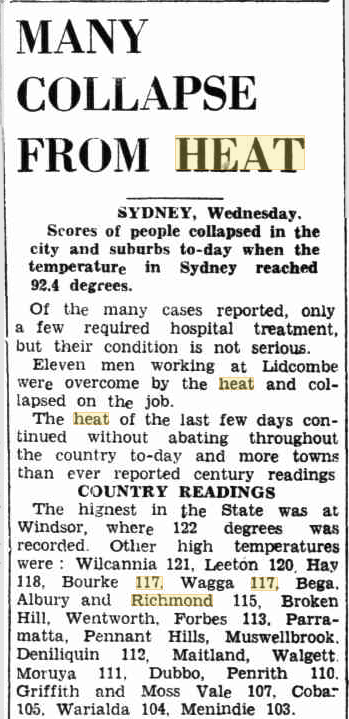This was Sydney before “Climate Change” hit — fifty degrees:
Penrith may have recorded 47.3C for at least one-second this week, but Windsor is only 23 km north-east of Penrith, and on January 13th, 1939, it recorded 122F or 50.5C with an old fashioned liquid thermometer, not a modern noisy electronic one.
Apparently, climate change makes our extreme heat less extreme.
Furthermore, this was not measured on a beer crate in someones back-yard, but on the historic Windsor Observatory which was built in 1863 by John Tebbutt F.R.A.S who had discovered The 1861 comet, and published many scientific reports in Astronomical Journals. His meteorological observations are published at Harvard in 1899 (among others). Tebbutt died in 1916, so it’s not clear what instrument the 122 F was recorded on in 1939, but a Stevenson Screen had been installed around 40 years earlier, and the measurement was made by Mr Keith Tebbutt, presumably his son.
Tebbutt’s portrait graced the back of our 100 dollar note from 1984 -1996.
See, Many Collapse in the Heat: Thursday Jan, 12, 1939, The Northern Star

Windsor Observatory | Photo: Winston M. Yang Wyp
All part of Greater Metropolitan Sydney
In 1939, I doubt either town was considered part of Sydney. But now both are on the metro network. Penrith is 54km from the CBD, Windsor, 56km. Notably, Windsor is a few train stops closer than Richmond, which the BOM acknowledges recorded 47.8C in 1939 on January 14, three days after the high of 122F recorded at Windsor.
Apparently Penrith that particular day, January 11th, was 110F, while Richmond was 115F or 46.1C. Neither Penrith nor Windsor appear to be recognised in BOM climate records.
Extreme heat of long ago — 48.2C (118F) at Windsor in 1896:
Thanks to Warwick Hughes, who has been looking at Windsor historic records too:
…click on the above link to read the rest of the article…
